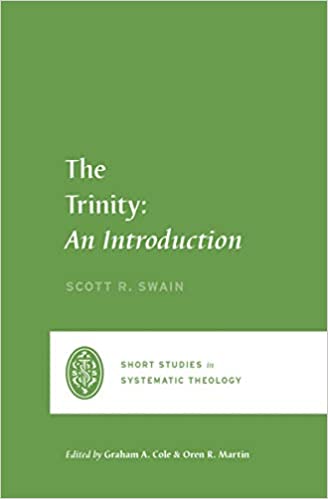A Brief Book Summary from Books at a Glance
By Kirsten Birkett
About the Author
Scott R. Swain is President and James Woodrow Hassell Chair of Systematic Theology at Reformed Theological Seminary in Orlando, Florida, where he has served since 2006. He is an ordained minister in the Presbyterian Church in America. Scott and his wife, Leigh, have four children.
Contents
Introduction
- The Bible and the Trinity: The Basic Grammar
- The Bible and the Trinity: Three Types of Texts
- The Simplicity of God
- God the Father
- God the Son
- God the Holy Spirit
- The Shape of God’s Triune Work
- The End of God’s Triune Work
Overview
An introductory overview of the doctrine of the Trinity: what it is, scriptural basis, and some implications for Christian life.
Introduction
Christians proclaim God as one in three persons and praise him for his being and his works. He wills to be our Father, through the Son, in the Spirit, and we are baptised in his name. This book is a short work of systematic theology, taking Scripture as its source and norm, and focusing on “scriptural patterns of naming the triune God,” and how this is confessed by the Church. The book aims to help Christians distinguish the true God from idols, help us receive and respond to the triune God, and promote fellowship with him. It does not aim to treat the historical development or polemical use of the doctrine, nor “more sophisticated dogmatic elaborations.” It begins with a survey of scriptural teaching on the Trinity, then moves to the doctrine of divine simplicity, each of the persons, God’s triune work, and finally a Trinitarian theology of ministry and the Christian life.
Summary
Chapter 1: The Bible and the Trinity: The Basic Grammar
God presents himself in Scripture as one God in three persons, the New Testament clarifying what was present but still ambiguous in the Old. The creeds are not developing something merely latent in Scripture; rather, they express biblical Trinitarianism for liturgical, pedagogical, and polemical purposes. Scripture is the source and norm for Trinitarian doctrine: “everything else is commentary.”
Christians are baptized into the name of the Triune God, and an exploration of this sets up three patterns of trinitarian discourse within the Bible. The first pattern is that the Bible affirms the existence of one God. God’s YHWH name signifies his self-existence, his simplicity, and his self-determination to accomplish his purpose and demonstrate his goodness. The second pattern consistently identifies the Father, Son, and Holy Spirit with the one God. They are not a group of gods, but three who are the one God. The third pattern is that the Bible consistently distinguishes the Father, Son, and Holy Spirit by their mutual relations – their relations to each other, not to us. The relations that the three persons hold to us (such as Creator, Redeemer, and Lord), do not distinguish them from each other. Their mutual relations are also asymmetrical. The Father begets the Son, and the Spirit proceeds from the Father and the Son, not vice versa. Various descriptions illuminate these relations: for example, the Son is the Word, the Image, and the radiance of God; the Spirit is poured out by the Father, the element in which Jesus baptises his disciples, the living water.
In conclusion, there are two kinds of predication of God in Scripture. The common predications in the Bible are “patterns of speech that refer to what the three persons of the Trinity hold in common with each other as the one God;” and proper predications are “patterns of speech that refer to that which distinguishes the three persons of the Trinity from each other.”
Chapter 2: The Bible and the Trinity: Three types of texts
Three types of biblical texts give a fuller sense of how the Bible speaks of the Trinity.
- Texts that allow us to overhear the persons of the Trinity speaking to and about each other. In Jesus’ baptism the Father calls Jesus his beloved Son and anointed him with his Holy Spirit. In Matthew 11:25-27, Jesus identifies God as his Father and himself as his Father’s Son (proper predication), and that he has the Father’s authority (common predication). Hebrews 1:5 clarifies that Psalm 2 is YHWH speaking to Jesus as his divine Son.
The remainder of this article is premium content. Become a member to continue reading.
Already have an account? Sign In
